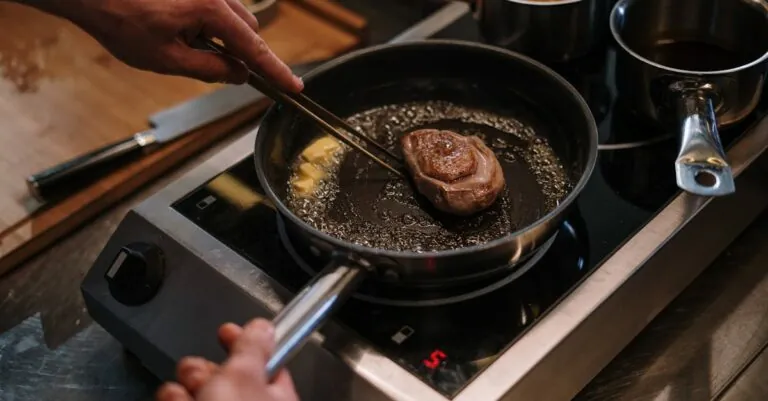Japanese cooking techniques are a delightful blend of art and science that can transform anyone into a culinary ninja. From the precision of sushi rolling to the delicate balance of flavors in miso soup, these methods elevate everyday ingredients into extraordinary dishes. It’s not just about cooking; it’s about creating an experience that tantalizes the taste buds and impresses dinner guests.
Table of Contents
ToggleOverview Of Japanese Cooking Techniques
Japanese cooking techniques emphasize precision and artistry, transforming simple configurations into exquisite culinary creations. Techniques such as sushi rolling require meticulous attention to detail. Chefs often focus on the freshness of ingredients, ensuring peak flavor profiles enhance every dish.
Umami, the fifth taste, plays a crucial role in Japanese cuisine. This depth of flavor often revolves around ingredients like soy sauce and miso. Balancing flavors stands central to Japanese cooking, especially in traditional meals such as miso soup and dashi stock.
Grilling also holds significance within Japanese techniques. Charcoal grilling, or yakitori, transforms ingredients through careful flame control, producing smoky, rich tastes. Steam cooking methods, like those used for shumai or chawanmushi, retain the natural essence of food while allowing for complex layering of textures.
Fermentation is another hallmark technique. Various fermented foods, including pickles (tsukemono) and miso, highlight traditional preservation methods. Each fermentation process enhances nutritional value while introducing distinctive tastes, making them foundational elements in many meals.
Presentation combines aesthetics and culinary technique in Japanese cooking. Dishes aim not just to please the palate but to create an engaging visual experience as well. This philosophy extends to elements like kaiseki, where seasonal ingredients manifest artfully arranged courses.
Understanding Japanese cooking techniques enriches culinary skills and elevates dining experiences. Mastering these practices invites an appreciation for the culture while inspiring creativity in the kitchen.
Essential Techniques

Japanese cooking techniques emphasize precision and artistry. Mastering these methods improves culinary skills and enhances flavor profiles.
Knife Skills
Knife skills stand as a cornerstone of Japanese cooking. Chefs learn to handle knives with great care, ensuring each cut is consistent and precise. Techniques like katsuramuki create delicate, thin sheets of vegetables. Slicing fish for sashimi requires a steady hand and acute attention to detail. Proper knife techniques not only enhance presentation but also improve texture and taste. Familiarity with different knife types, such as the deba and yanagiba, aids in achieving specific cuts. Attention to maintenance ensures blades remain sharp, which is crucial for effective performance.
Cooking Rice
Cooking rice serves as a fundamental technique in Japanese cuisine. Short-grain rice, known for its stickiness, forms the base of many traditional dishes. Rinsing rice removes excess starch, leading to a fluffier texture. Soaking enhances absorption, ensuring even cooking. Using the right water-to-rice ratio is essential; typically, one cup of rice requires about 1.2 cups of water. Utilizing a donabe or rice cooker simplifies the process, consistently producing tender grains. Steaming rice after cooking allows moisture to redistribute, resulting in an ideal texture perfect for sushi or serving as a side.
Cooking Methods
Japanese cooking embraces a variety of techniques that enhance flavors and elevate dishes. Each method serves a unique purpose, reflecting the cultural depth and precision of Japanese cuisine.
Steaming
Steaming stands out as a key cooking method in Japanese kitchens. This technique preserves the natural flavors and nutrients of ingredients, maintaining their vibrant colors and textures. Often used for vegetables, fish, and dumplings, steaming ensures that food retains moisture without adding extra fats. Common tools include the bamboo steamer and the donabe, a traditional clay pot. Dishes like chawanmushi, a savory egg custard, exemplify the delicate flavors achieved through steaming.
Grilling
Grilling captures the essence of Japanese outdoor cooking, particularly through techniques like yakitori. This method involves skewering bite-sized pieces of chicken and grilling them over charcoal, leading to a smoky flavor profile. Grilling enhances the natural sweetness of ingredients while creating a charred and crispy exterior. Seasonal vegetables, fish, and even tofu often join chicken on the grill, showcasing the technique’s versatility. The process emphasizes the beauty of simplicity, allowing the ingredients to shine.
Sautéing
Sautéing adds depth and complexity to Japanese cuisine. This method utilizes high heat and a small amount of oil to cook ingredients quickly while preserving their integrity. Stir-frying vegetables and proteins creates a harmonious blend of flavors and colors. Dishes like yasai itame demonstrate the effectiveness of sautéing, where seasonal vegetables burst with freshness. Proper technique involves consistent stirring, ensuring even cooking without burning.
Braising
Braising highlights the art of slow cooking in Japanese dishes. This method combines moisture with low heat, allowing flavors to meld and deepen over time. Commonly used for meats, braising results in tender, richly flavored dishes. Classic examples include nikujaga, a comforting stew of sliced beef and potatoes, simmered in a savory sauce. The technique embodies patience and care, transforming simple ingredients into memorable meals.
Flavoring Techniques
Flavoring techniques in Japanese cooking reflect a deep understanding of ingredients and their interactions. These methods enhance the overall dining experience through careful seasoning and unique flavor profiles.
Fermentation
Fermentation plays a vital role in Japanese cuisine, contributing depth and complexity. Foods like miso and pickles highlight the transformation of ingredients through this process. Miso, formed by fermenting soybeans with koji, adds umami richness to various dishes. Pickled vegetables, such as tsukemono, serve as palate cleansers while providing nutritional benefits. This technique preserves ingredients while infusing them with distinct flavors. Fermented foods offer not just taste but also a cultural connection, showcasing traditional practices passed down through generations.
Seasoning with Soy Sauce and Miso
Soy sauce and miso are cornerstone seasonings in Japanese cooking, enhancing flavors with their unique profiles. Soy sauce, crafted from fermented soybeans, delivers a salty and savory depth that elevates dishes like sushi and sashimi. Miso serves a dual purpose, acting as both a seasoning and a base for soups and marinades. The variety in miso types, from white to red, allows for different flavor intensities in cooking. Both ingredients create rich umami experiences, highlighting the balance sought in Japanese cuisine. Proper use of these seasonings showcases a chef’s skill, transforming simple ingredients into complex and flavorful meals.
Japanese cooking techniques offer a unique blend of artistry and precision that can transform any meal. By mastering these methods chefs can elevate simple ingredients into unforgettable culinary experiences. The focus on umami and the careful balance of flavors enhances both taste and presentation.
Whether it’s through the meticulous art of sushi rolling or the delicate process of fermentation each technique plays a vital role in creating memorable dishes. Embracing these practices not only enriches cooking skills but also deepens appreciation for the cultural significance behind each meal. Exploring Japanese cuisine opens doors to a world of flavors and creativity that can inspire any home cook.







